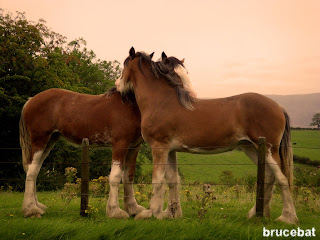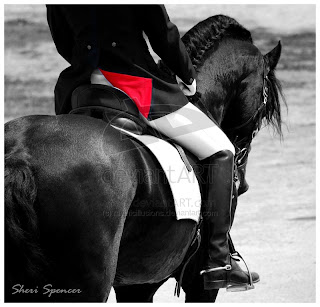
Ahhh, don't you just love these gentle- giants? So beautiful and so HUGE! I just love'em! This breed is so gigantic that they have held the world record for the world's largest horse more than once. They range in height from 17 to 19hh, and a average Shire weighs over 1 ton, but they can pull up to 5 tons by their selves! Once at th e Wembley Exhibition in 1924 a pair pulling against a dynamometer (a machine used for measuring mechanical power) exceeded the maximum reading and were estimated to have exerted a pull equal to a load of 45 tons! Thats just amazing to me. These horses are thought to be descendants of a horse of medieval horse, called 'The Great Horse', that were used to carry knights in full armor. We know for sure that this horse, the Friesian, and the Flemish or Flanders horse have been influences on the Shire. They
e Wembley Exhibition in 1924 a pair pulling against a dynamometer (a machine used for measuring mechanical power) exceeded the maximum reading and were estimated to have exerted a pull equal to a load of 45 tons! Thats just amazing to me. These horses are thought to be descendants of a horse of medieval horse, called 'The Great Horse', that were used to carry knights in full armor. We know for sure that this horse, the Friesian, and the Flemish or Flanders horse have been influences on the Shire. They  come in bay, brown, black, and gray.
come in bay, brown, black, and gray.
 e Wembley Exhibition in 1924 a pair pulling against a dynamometer (a machine used for measuring mechanical power) exceeded the maximum reading and were estimated to have exerted a pull equal to a load of 45 tons! Thats just amazing to me. These horses are thought to be descendants of a horse of medieval horse, called 'The Great Horse', that were used to carry knights in full armor. We know for sure that this horse, the Friesian, and the Flemish or Flanders horse have been influences on the Shire. They
e Wembley Exhibition in 1924 a pair pulling against a dynamometer (a machine used for measuring mechanical power) exceeded the maximum reading and were estimated to have exerted a pull equal to a load of 45 tons! Thats just amazing to me. These horses are thought to be descendants of a horse of medieval horse, called 'The Great Horse', that were used to carry knights in full armor. We know for sure that this horse, the Friesian, and the Flemish or Flanders horse have been influences on the Shire. They  come in bay, brown, black, and gray.
come in bay, brown, black, and gray. In the late 19th and early 20th century Shires were exported in large numbers to America. But later in the 20th century, when machinery began to take the place of humans and horses alike, the breed hit an all-time low. Fortunately, in the 70s people began to take notice of this humble breed and Shires have been popping up in show rings every since. Even so, population numbers are still considered to be at critical levels by Both the UK-based Rare Breeds Survival Trust and the US-based American Livestock Breeds Conservancy.
Today the breed is still used by farmers as plow horses, they are also used for pulling brewery wagons that deliver ale to cosomers. They can be seen in show rings everywhere, and make all-around good horses. I just love these guys!
;o)


















